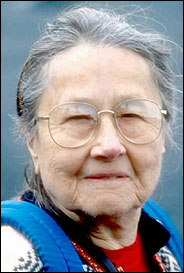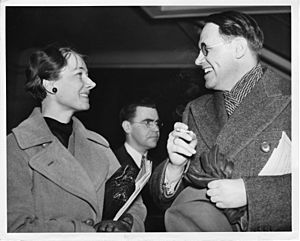Frederica de Laguna facts for kids
Quick facts for kids
Frederica Annis Lopez de Leo de Laguna
|
|
|---|---|

Frederica de Laguna in 1993.
|
|
| Born | October 3, 1906 Ann Arbor, Michigan
|
| Died | October 6, 2004 (aged 98) Haverford, Pennsylvania
|
| Other names | Freddy |
| Citizenship | American |
| Alma mater | Phoebe Anne Thorne School, Bryn Mawr College, Columbia University |
| Known for | Under Mount Saint Elias: The History and Culture of the Yakutat Tlingit |
| Scientific career | |
| Fields | anthropology, archaeology, ethnology |
| Institutions | Bryn Mawr College |
| Thesis | "A Comparison of Eskimo and Palaeolithic Art" (1933) |
Frederica ("Freddy") Annis Lopez de Leo de Laguna (October 3, 1906 – October 6, 2004) was an important American scientist. She studied people and cultures, both past and present. She was an ethnologist, anthropologist, and archaeologist.
Frederica de Laguna was known for her work in Alaska and the American Northwest. She studied ancient people (called Paleo-Indians) and the art and history of Alaska Native groups.
She helped start the anthropology department at Bryn Mawr College. She led it from 1938 to 1972. She was also a leader in major scientific groups. She was vice-president of the Society for American Archaeology (1949–1950). She also served as president of the American Anthropological Association (1966–1967).
De Laguna received many awards for her work. In 1975, she became one of the first women elected to the National Academy of Sciences. She shared this honor with her classmate Margaret Mead. She also received a special ceremony called a "potlatch" from the people of Yakutat in 1996.
Early Life and Education
Frederica de Laguna was born on October 3, 1906. Her parents, Theodore and Grace de Laguna, were philosophy professors. They taught at Bryn Mawr College. Frederica was born in Ann Arbor, Michigan.
She was often sick when she was young. Because of this, her parents taught her at home until she was nine. As a teenager, she traveled with her family. They spent time in England and France.
Frederica went to Bryn Mawr College from 1923 to 1927. She earned a degree in politics and economics. She graduated with top honors. She then decided to study anthropology at Columbia University. There, she learned from famous scientists like Franz Boas and Ruth Benedict.
In 1928, de Laguna traveled to Europe. She gained experience doing fieldwork in England, France, and Spain. She also attended lectures on ancient art. In 1929, she went to Greenland. She helped with the first scientific archaeological dig there. This six-month trip made her sure she wanted to be an anthropologist. She later wrote a book about this trip called Voyage to Greenland (1997). She earned her PhD in anthropology from Columbia University in 1933.
Career and Discoveries
Frederica de Laguna's first big research trip was to Alaska in 1930. She explored Prince William Sound and Cook Inlet. Her brother Wallace, who was a geologist, joined her as an assistant. The University of Pennsylvania Museum helped fund her work. They hired her to study their collections of Eskimo artifacts. They also paid for more digs in Cook Inlet in 1931 and 1932.
In 1933, she worked with Kaj Birket-Smith in Prince William Sound. They studied both archaeology and ethnology. This trip led to her book "The Eyak Indians of the Copper River Delta, Alaska" (1938). She also explored the Yukon Valley and Tanana River in 1935. This work resulted in two more books: Travels Among the Dena (1994) and Tales from the Dena (1997).
Bryn Mawr College hired de Laguna in 1938. She taught the college's first anthropology course. During World War II, she took a break from teaching. She joined the Women Accepted for Voluntary Emergency Service (WAVES). She was a lieutenant commander in the naval reserve. She taught naval history to women at Smith College until 1945.
After the war, she returned to Bryn Mawr College. In the 1950s, she went back to Alaska. She studied the Yakutat Tlingit people. Her detailed three-volume book about them is considered the best work on the Yakutat Tlingit.
Even after retiring in 1975, de Laguna stayed active. She traveled to Upernavik, Greenland. She also volunteered for the U.S. Forest Service in Alaska. She even started her own publishing company, Frederica de Laguna Northern Books Press.
Over 5,000 objects she collected are now at the Penn Museum. These items help us learn more about the cultures she studied.
Selected Works
- 1930, The thousand march: Adventures of an American boy with the Garibaldi
- 1937, The arrow points to murder
- 1938, Fog on the mountain
- 1972, Under Mount Saint Elias: The history and culture of the Yakutat Tlingit: Part one
- 1977, Voyage to Greenland: A personal initiation in anthropology
- 1991, with George Thornton Emmons, The Tlingit Indians
- 1994, with Norman Reynolds and Dale DeArmond, Tales from the Dena: Indian stories from the Tanana, Koyukuk, and Yukon rivers
- 1997, Travels among the Dena: Exploring Alaska's Yukon valley
See also
 In Spanish: Frederica de Laguna para niños
In Spanish: Frederica de Laguna para niños


